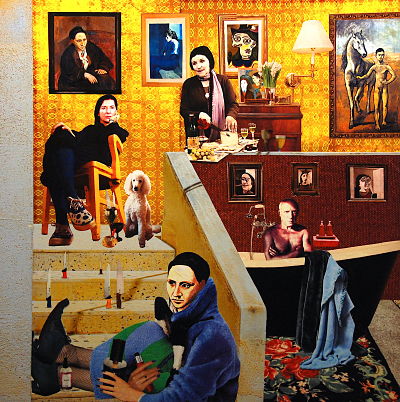
Ms Abramovic and Miss Stein Discuss Stair Treatments
June 2018. I find a guy by the name of Slap Happy Larry, not to be confused with Happy Larry. He likes drawing stairs and is a big fan of using them in picture books. They’re useful as symbols. As a device to show without saying. And we understand this kind of thing. Put the powerful guy at the top of the stairs next to the saint. The weak and the bad near the bottom. Stairs allow for transitions. For connections. Between stories, for instance. Some people don’t like stairs for that reason. Stairs insist on there being at least two stories and that can be a problem.
We find performance artist Marina Abramovic and novelist/poet Gertrude Stein each sitting on a story separated by a staircase. Abramovic on the second story, Stein on the first. I am not aware of any particular power dynamic. If there is an upper hand, I’d cast my vote with Stein as it’s her home. As for their discussion on the topic of stairs, they’re in partial agreement about not using them in the conventional way, that is, as a means to move from one story to the next.
As for the stories, here’s Abramovic’s: It’s called The House With The Ocean View. A performance piece in which she sits, stands, lies down, drinks water, uses the toilet and takes a shower on a raised platform over a period of twelve days and nights. Three platforms actually. All this in front of an audience. There are three sets of stairs, well, ladders, one in front of each platform. And if you look closely you’ll note the rungs are made of large butcher knives. Immediately the connection between the ladders and their normal function is lost, the meaning subverted. Instead of serving as a means for Abramovic to leave the platform or audience members to join her, they’re mocking the entire notion of access. And of course, this is the point.
Miss Stein’s story: It’s in the October 13, 1934 issue of the New Yorker and has to do with her daily routine. Is called: Tender Buttons. (I love hearing about this sort of thing.) Every morning Stein gets up at ten and drinks some coffee, her partner Alice Toklas already up for hours dusting and fussing around. At some point Stein bathes and combs the poodle, brushes his teeth, and either before or after, bathes herself in an oversize bathtub made especially for her. The tub is so large the staircase has to be taken out in order to install it. Post bath she puts on a huge woollen bathrobe, finally ready to write. From this we gather that accessing the second story is not as important a priority as bathing for Miss Stein.
I plan to add one more story. One more staircase. Something to do with the Scala Sancta. And three is a good number. In some instances better than two. But I come under the influence of singer/songwriter Bruno Mars who apparently does not approve of there being more than one story and certainly sees no need for stairs. Consider then how disturbing three stories must be. In deference to him I leave this last one alone, at the same time taking issue with his notion that one story is enough. Is it even possible? In some cases, I suppose. Like in the homes of seniors, although my old dad made it up and down his staircase until about a week before he died. On the second story. But in terms of Ms Abramovic or Miss Stein it’s impossible to contain these women in just one. They would each need at least ten. And I say this because I read once that a person could be contained in or defined by the ten jokes they told most often during their life time. Here’s one of Abramovic’s: How many hours does a performance artist need to change a light bulb? Answer: I don’t know. I was only there 6 hours. She tells this joke 7 times before she gets it right. Here’s one of Stein’s: What makes the place settle and the plate distinguish some specificities? I don’t know. Tell me. What makes the place settle and the plate distinguish some specificities? The answer: The whole thing isn’t understood and this isn’t strange considering there is no education.
It’s time to end. Slap Happy Larry talks about people who can’t end a story. He suggests they move toward the end by letting the reader know what the main characters have learned since the story began and revealing something of how things will be different from now on. My two characters will have learned how to tell better jokes and subsequently their friends and followers will laugh more easily and heartily. Abramovic will put away her knives and Stein will take even longer baths than previously.